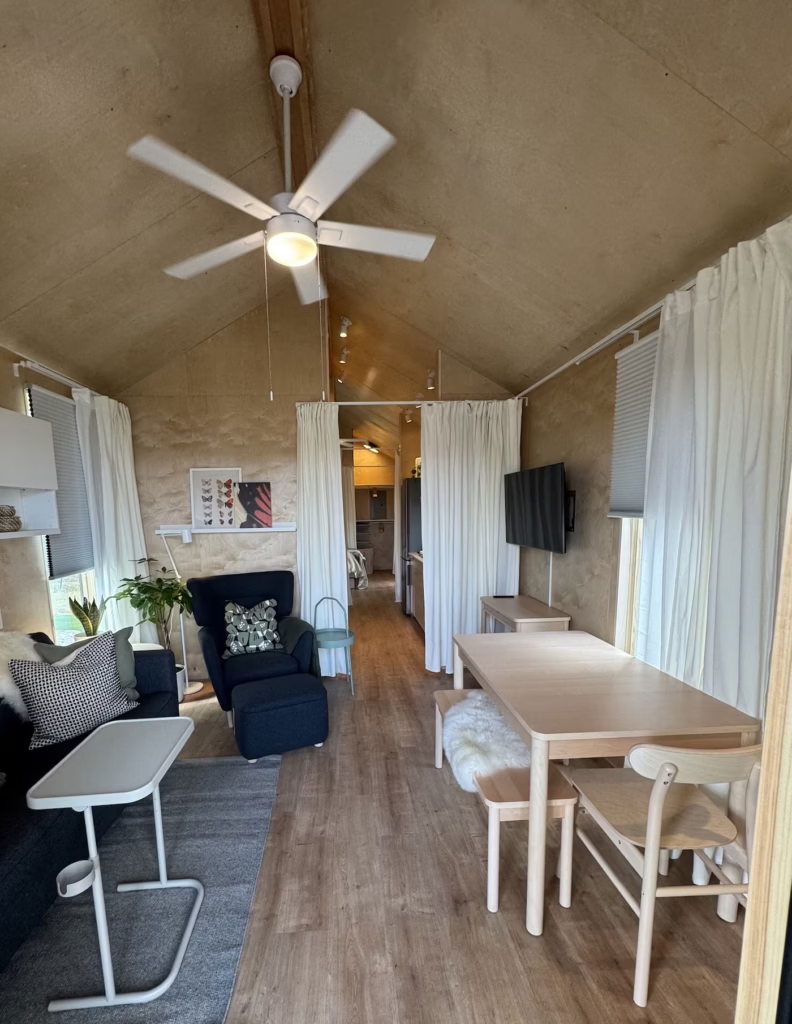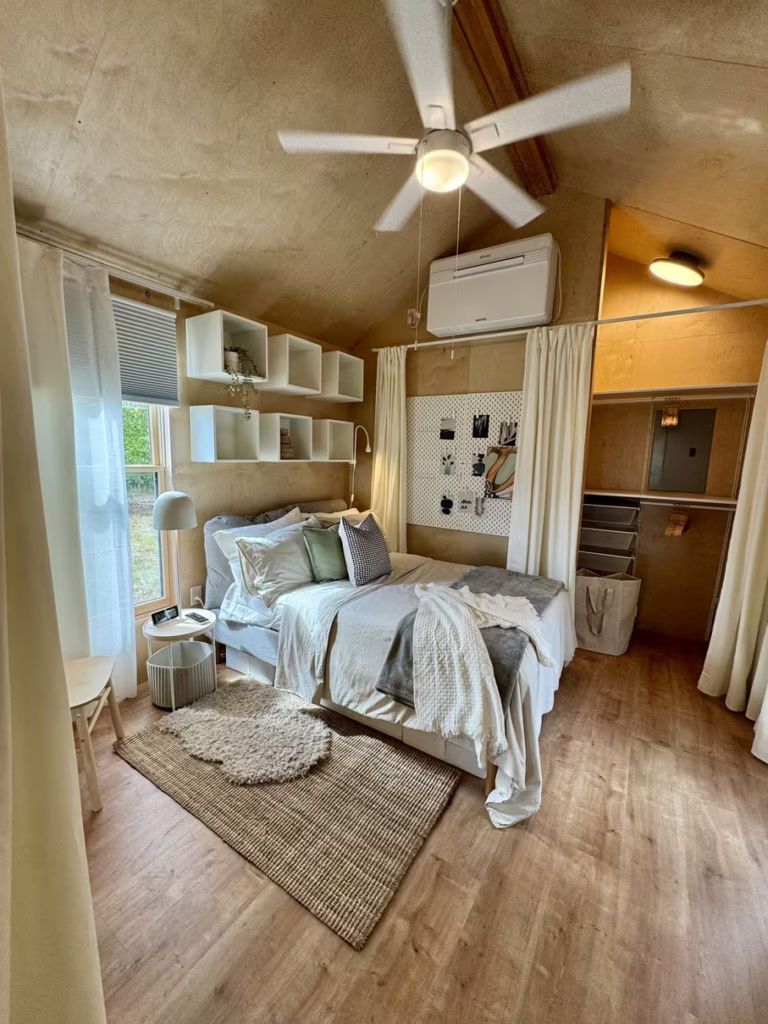On a crisp autumn morning in San Antonio’s East Side, a single tiny home made waves in the fight against chronic homelessness. While the global retailer IKEA is known for modern furniture and flat-pack shelves, this time they brought something far more transformative: a tiny house specifically designed with “trauma-informed design” (TID) to serve a population often forgotten—homeless seniors.
The house, donated to Towne Twin Village in fall 2024, may appear modest—about 400 square feet with a warm color palette—but behind each thoughtful detail lies a bigger story of resilience. The brand that’s redefined small-space living aims to show that a well-crafted, empathy-based environment can speed up healing from years of trauma on the streets. In a city grappling with a shortage of affordable housing and a rising population of older adults experiencing homelessness, the timing couldn’t be more pivotal.
From Idea to Action: The Towne Twin Village Story
Towne Twin Village stands on the grounds of a once-popular drive-in theater, which screened its final movie more than 35 years ago. Where families once watched flickering films under Texas stars, today you’ll find a 17.3-acre haven dedicated to permanent supportive housing. Its mission? House more than 200 seniors—aged 50 or older—who’ve lived without stable shelter for extended periods, often while facing physical disabilities, mental health struggles, or substance abuse issues.
Developed by the Housing First Community Coalition (HFCC) and guided by “Housing First” principles, Towne Twin Village provides not just a roof, but wraparound services like counseling, healthcare, job training, and social activities to foster community. The approach is simple yet radical: meet people where they are, no strings attached. Once you have a safe place to live, the path to addiction recovery or mental health treatment becomes infinitely more feasible.
“You don’t have to be clean and sober. You don’t have to have income,” founder Chris Plauche told the San Antonio Report. “We’re trying to make a place where each person is valued and can build a new life.”
Enter IKEA: Why Trauma-Informed Design?
Trauma-informed design is an emerging field that recognizes how physical spaces can either aggravate a person’s sense of insecurity or, conversely, nurture their healing. It draws insights from mental health professionals, architects, and research on how light, safety features, and comfort levels shape well-being.
According to The National Alliance to End Homelessness, over 80% of people experiencing homelessness have faced significant trauma—whether violent crime, assault, or the perpetual fear and stress of life on the streets. The goal of TID is not simply to avoid “triggers” but to create spaces that restore dignity and inspire trust.
Key TID Principles
- Natural Light: Large windows or translucent panels evoke warmth, reduce stress, and help regulate the body’s circadian rhythms.
- Open Layout: Minimizes claustrophobia and fosters an easy sense of flow—crucial for those who’ve dealt with cramped shelters.
- Safe Accessibility: Everything from slip-resistant floors to easy-to-navigate doors helps seniors with mobility issues.
- Flexible Furniture: Multipurpose items allow for guests or personal routines, acknowledging that every occupant has unique social needs.
- Privacy + Community: Striking a balance with personal space yet ensuring welcoming communal areas.
As Sam Eisenman, sustainability business partner at IKEA U.S., stated in a press release, “IKEA U.S. is uniquely positioned to amplify empathy-based design approaches.” By harnessing their well-known expertise in small-space solutions, IKEA extends its motto—“a better everyday life”—to older adults in dire need of stable housing.


The House That Empathy Built
For the Towne Twin Village pilot project, IKEA’s design stands out:
Combined Shower & Tub: According to data from the HFCC, residents prefer having bathing options. So, no “shower-only” setups.
Flexible Furniture: A daybed that converts into a couch, letting residents host guests or reorganize space easily.
Neutral, Calming Palette: Muted earth tones, reminiscent of nature—found to lower anxiety levels.
Smart Layout: Clear lines of sight and wide doorways help those with walkers or wheelchairs.
From the door handle’s shape to the vantage point of windows, everything is tested to reduce stress triggers—like loud slamming doors or harsh fluorescent lights. The outcome? A space that not only fosters physical safety but also eases mental burdens.
Homelessness Among Seniors
Despite little media attention, older adult homelessness is climbing across major U.S. cities, including San Antonio. Close to Home San Antonio, formerly South Alamo Regional Alliance for the Homeless (SARAH) discovered a 66% rise in chronically homeless individuals aged 50+ between 2020 and 2021. Factors driving this include fixed incomes that can’t keep pace with skyrocketing rents, health setbacks, and diminishing social safety nets.
At Towne Twin Village, the average occupant battles multiple barriers: advanced age, limited mobility, mental health conditions, and the stigma of homelessness. TID targets this specific intersection of vulnerabilities. By removing architectural hurdles, it eliminates a silent contributor to recidivism—feeling unsafe or disoriented in new accommodations.
Why Housing First? The Data Speaks
Housing First is anchored in the idea that providing stable housing is the first step in addressing other personal challenges. Numerous studies—like those by the U.S. Department of Housing and Urban Development—show that Housing First programs have higher rates of retention and better long-term outcomes than “housing ready” models, which require sobriety or job placements beforehand.
At Towne Twin, a homeless senior can move in “as is” and then access:
Healthcare Clinics: Physical, mental, and dental.
Case Management: One-on-one support to tackle paperwork, ID retrieval, or Medicaid enrollment.
Recreational Activities: A community garden, amphitheater, and art spaces.
Peer Volunteers: Known as “PALs,” living on-site to reduce isolation.
“It’s not going to be easy,” Plauche told reporters, but “that’s the beauty of Catholic Worker House: they come to us every day.”
Overcoming Obstacles
Though the potential is enormous, the project faced roadblocks:
Funding: With a price tag over $41 million for the entire campus, city and county grants only stretch so far. Private donors stepped up, bridging the gap.
Construction Delays: Supply chain issues and labor shortages postponed move-in dates.
Complex Social Needs: Many residents require mental health therapy, addiction services, and physical rehabilitation.
Volunteers, philanthropic groups, and robust city support keep the vision afloat, reinforcing the idea that collaboration is essential to solve homelessness.
A Model for the Future
Leaders from across the country have taken note of Towne Twin Village’s approach—merging Housing First, permanent supportive housing, and TID. If IKEA’s pilot proves successful, we may see a wave of TID-based tiny homes for seniors in Memphis, Washington D.C., and beyond. “This is the beginning of a journey at IKEA,” the company says, as they train employees and refine trauma-informed guidelines.
What’s unique is that TID addresses emotional well-being, not just physical shelter. It speaks volumes that a multinational brand like IKEA invests resources in designing spaces so specifically for those who have survived tremendous hardship. And with over 2,900 chronically homeless individuals in San Antonio alone, according to HFCC, the need is urgent.
How to Get Involved
- Volunteer or Donate: Your contributions help furnish and outfit tiny homes, providing essential resources for those in need.
- Learn About TID: Encourage local shelters, architects, and city planners to embed trauma-informed principles into new builds.
- Spread Awareness: Share the success of TID-based housing solutions on social media or in community forums.
- Support Senior Services: Many older adults living precariously close to eviction could benefit from specialized rental assistance and mental healthcare.
Designing Hope
In a world where older adults often vanish into the shadows of our bustling cities, one small, thoughtfully designed home stands as a beacon of compassion. By focusing on warmth, natural light, and occupant dignity, IKEA’s trauma-informed approach proclaims that healing and security can be built into the very walls around us.
Towne Twin Village might be a microcosm—just 17 acres of colorful houses and shared courtyards—but it embodies a new way to solve entrenched social problems. Instead of seeing seniors with histories of homelessness as “risky,” it treats them as neighbors and ensures every fixture, from faucet to floor tile, fosters well-being.
As we reevaluate how to best house our most vulnerable, we can look to this quiet corner of San Antonio for inspiration—and remember that sometimes, a caring design can truly shape second chances.
Whether in your own neighborhood or across the globe, consider how trauma-informed design could uplift those on society’s margins. Advocate for TID in affordable housing projects, volunteer with a local nonprofit tackling homelessness, or donate to expansions at Towne Twin. Because when a simple house can restore dignity, we all share the foundation of hope.
Header image via IKEA U.S.

